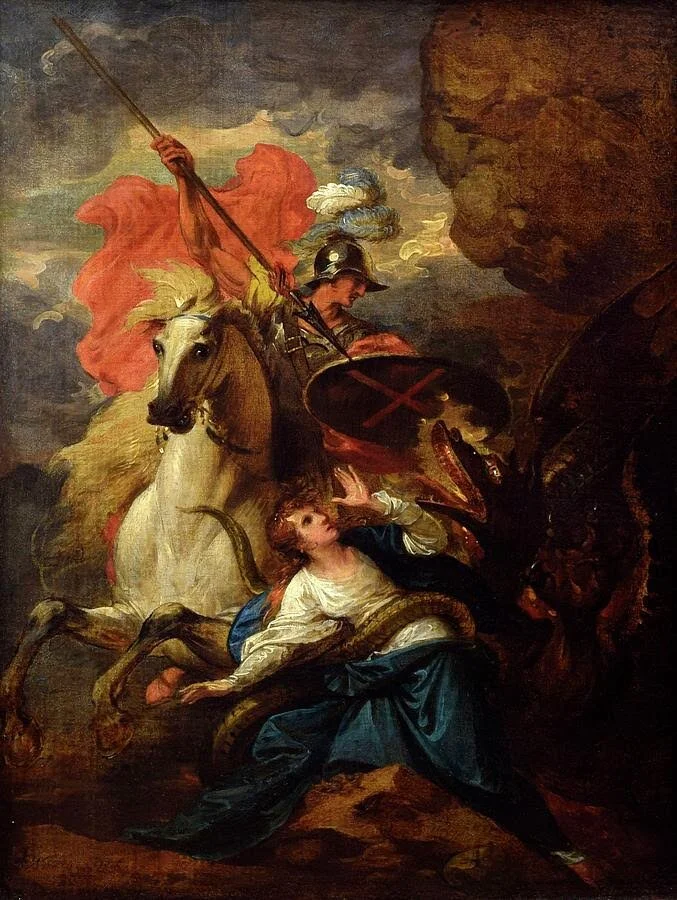Memorial of Saint George, Martyr
George. The English equivalent of the Greek Georgios, derived from the Greek word γεωργός (geōrgos), "land worker", "farmer", which became a name in Greek: Γεώργιος (Geōrgios) and in Latin Georgius. The word γεωργός was created by combining the words γῆ (Ge), "earth", "soil" and ἔργον (ergon), "work".
Saint George my Saint Patron
Saint George - a great knight - usually depicted in art and painting, on a fiery steed, striking a terrible dragon with a spear. He is one of those saints whose person is surrounded by numerous legends, myths or even fairy tales. However, he is a historical figure.
Saint George - a soldier and martyr - is one of the most famous saints in both the Eastern and Western Church. We have truly little information about his life and activities. This is because when the Middle East, that is Minor Asia, was occupied by the Turks, then they aimed at the complete destruction of Christianity there and erasing all traces of it. Temples and places of worship were demolished. Pictures, sculptures and monuments were destroyed - everything that had anything to do with Christianity. However, the worship of the holy martyrs for their faith in Christ remained among the faithful, and among them the cult of Saint George, a soldier and martyr, was very much alive. In Christian antiquity, the cult of St. George was particularly lively. Emperor Constantine the Great erected a magnificent basilica in Jerusalem in his honor at the beginning of the 4th century, ruins of which were discovered in 1953. In the 6th century his tomb in Lydda, Palestine, was a place of numerous pilgrimages; there the saint was honored in a special way.
According to the multitude hagiography of Saint George, his father Gerondios was supposed to come from Persia and his mother Polychronia from Cappadocia. It was a very pious marriage. The greatest pain was that they were childless. They made many requests to God, did penance, fasted - all in order to obtain a child from God. It was only in old age that God heard their request and gave them a son - George. He was born in Cappadocia. Raised with great concern by parents in the faith of Christ. He grew "in wisdom and grace with God and men." As a noble and exemplary youth, he was an example to his colleagues. Soon he enlisted in the imperial army. As a legionnaire, he gradually rose to the rank of a higher officer. When the persecution of Christians under the Emperor Diocletian broke out, George was a high Roman official - a tribune, that is, the head of the local garrison with the rank of colonel. Since Christianity was spreading more and more, also penetrating the ranks of the imperial army, the emperor issued a decree forbidding the adoption of Christian faith and ordered all soldiers to make a sacrifice at the front of the statues of pagan Roman deities.
George was well aware of what he should expected when it was revealed that he was a Christian. Besides, he never hid his religious convictions. He was an exemplary, model, straightforward man. He was not ashamed of his faith. He knew that he would be persecuted as a follower of Christ. He distributed his property to the poor, and when summoned to the emperor, he steadfastly refused to offer sacrifices to pagan deities and renounce Christianity. For example, and to intimidate others, he was first interrogated and then subjected to extremely cruel torture. Indeed, it must have been great, since the Eastern Church - among so many martyrs of this period - gave him the title of Great Martyr. He was martyred probably in Lydda (Diospolis) - later named after his name Georgiopolis (Georgius - George) - around 304. His heroic life has been described in many countries in numerous biographies, showing him as an exemplary knight, high-ranking officer in the imperial army, extremely courageous, distinguished by mercy towards the poor and unhappy, zealous apostle of Christ, undertaking all kinds of suffering for the Church and the Faith of Christ. St. George was canonized in AD 494 by Pope Gelasius, who claimed he was one of those 'whose names are justly revered among men but whose acts are known only to God'. A feast day of St George has been celebrated on 23 April, which was possibly the date of his martyrdom.
His cult in the East was so popular that he ranked first after the Blessed Virgin Mary and St. Michael. In Egypt and Cyprus alone, 60 churches had been built in his honor, and there was not a single temple without his image. The cult of Saint George spread shortly after his death and spread to all countries around the Mediterranean Sea quite early. First in Egypt, Cyprus, Asia Minor, where there were over 60 places of his memory, and then in other countries. In the Caucasus, the entire province got its name from his name: Georgia (today an independent Country).
In the Western Church, the cult of Saint George dates back to the 6th century. Then a church was built in Rome, dedicated to him. Soon other cities in Italy turned themselves over to his overwhelming protection, choosing him as their patron, such as Ferrara, who had the relics of his head since the Crusades. The Crusaders contributed significantly to the spread of his cult in Western Europe. After the Crusades, Saint George became the main patron of European knights, and England chose him as its special patron in 1222. He is also the patron of various church fraternities and associations; medals of Saint George, known as orders, were also established. In England, for example, the Order of Saint George was called the "Order of the Garter". He is also the patron of Lithuania, which has his image on their coat of arms. His image was placed on the coat of arms by the Grand Duchy of Moscow. Coins were minted there with his image, and in Russian museums there are many icons dedicated to him. Saint George is a National Saint of Georgia, England, Ethiopia, Iberia, Catalonia, Aragon, Valencia, Portugal, Brazil, Russia, Bulgaria, Serbia, Montenegro and Poland.
In iconography, the saint is shown in a short tunic as a knight on horseback slaying a dragon. Its attributes are: an angel with a laurel wreath or a crown, a lamb, a white banner or a lance with a red cross, a horse, a palm of martyrdom and, among others, the objects of his torment - nails, a millstone and a wheel, a sword, a dragon at his feet, a slain dragon. The dragon on the painting (symbolizing Satan) comes from the tales of St. George, probably medieval. The history was described, among others, by Jacopo De Fazio, best known as the blessed Jacobus de Varagine, OP around 1260 in the "Golden Legend". The dragon made its nest on the spring that supplied the water for the city of Silene (possibly later Cyrene in Libya). For the time of taking water, the inhabitants had to drive out the dragon. In order for the monster to move, it had to get a sheep each day. When the sheep ran out, the townspeople had to give up one of the girls every day.
The victim was selected by drawing. Once upon a time, a drawing selected a princess. The monarch begged for her life, but to no avail. She was about to be offered to the dragon when Saint George appeared on his way. He came face to face with the dragon, crossed himself with the sign of the cross, defeated the dragon and saved the princess. The grateful city abandoned paganism and converted to Christianity.
The weapon that St. George defeated the dragon, they were called Ascalon. On the site where the dragon fell, the king built a church dedicated to the Blessed Virgin Mary and St. George.
Prayer for St. George
St. George, Heroic Catholic soldier and defender of your Faith, you dared to criticize a tyrannical Emperor and were subjected to horrible torture. You could have occupied a high military position, but you preferred to die for your Lord. Obtain for us the great grace of heroic Christian courage that should mark soldiers of Christ. Amen
Until Tomorrow
fr. george


